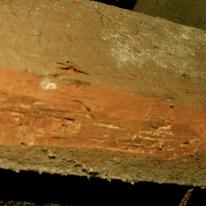Roof framing – borer
Listed under: Interior, timber and wood-based, health and safety, chemicals, timber, Roof, roof space, durability, borer
Cause
High moisture content of timber
Repair
-
address the roof space dampness first:
-
identify and repair any leaks in roofing, penetrations, flashings or pipes. If the location of the leak is difficult to find, or there may be multiple leaks, call a registered building surveyor to investigate and recommend solutions
-
if moist subfloor air is moving through a wall cavity into the roof space, block off the area at the bottom of the wall
-
if moist air from kitchen/bathroom is moving into the roof space through ceiling vents or open recessed downlights, redirect vented air to the outside and replace the downlights with lighting that does not allow air movement
-
a few borer holes are not uncommon in older homes and are unlikely to compromise the structural performance of the timber. (A lot of native framing timber has a high proportion of heartwood, and common borer only consume sapwood.). The best indication of whether borer are still active is the appearance of fresh holes and dust October to March
-
if the infestation is extensive and there is considerable damage visible, consult a specialist pest destruction company that is a member of the Pest Management Association of New Zealand. Fumigation is best during the flight season October–March
-
replace badly infected timber with minimum H1.2-treated timber or strengthen infected timber by fixing new timber to affected timber once the infestation has been treated. Ensure that new timber extends a minimum of 600 mm beyond the infected area
Cause
Use of untreated timber or native sapwood timber
Repair
-
check level of infestation and level of damage and fumigate if necessary as described above
-
replace badly infected timber with minimum H1.2-treated timber or strengthen infected timber by fixing new timber to the infected timber once the insect infestation has been treated. Ensure that new timber extends a minimum of 600 mm beyond the infected area




